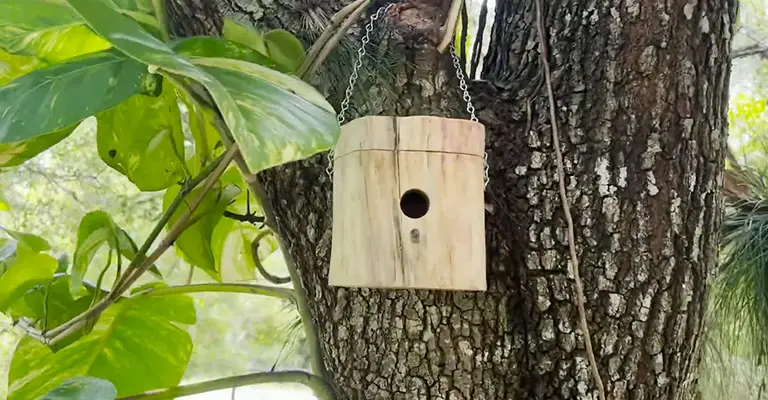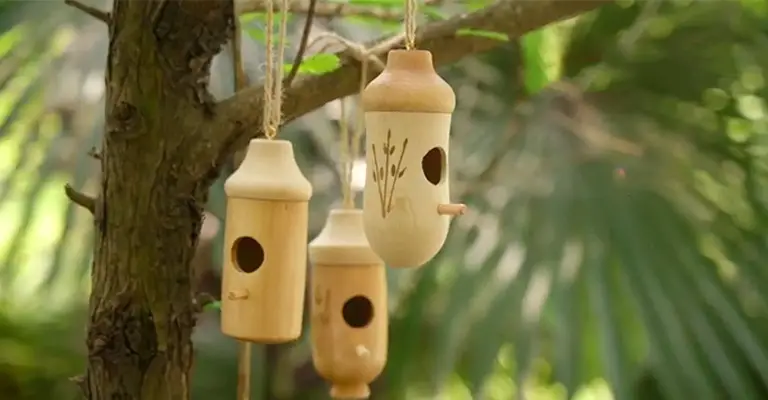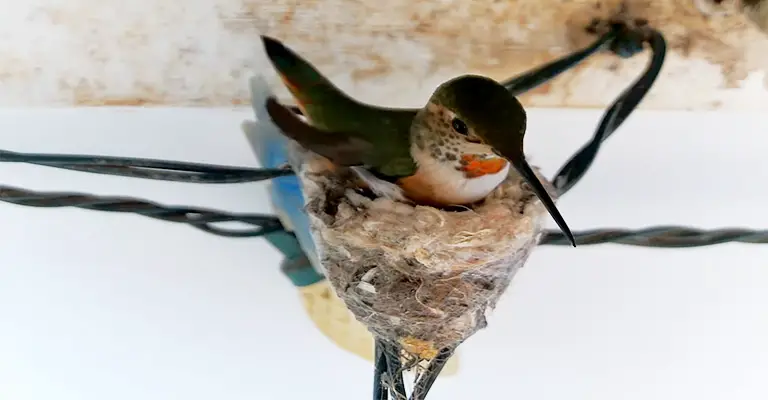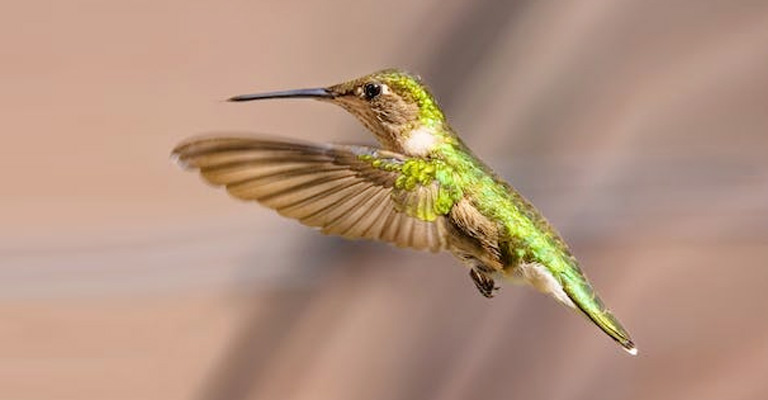Hummingbirds, with their dazzling iridescence and ethereal presence, are a beloved addition to any garden. If you wish to attract and provide a suitable nesting habitat for these tiny marvels, knowing where to hang hummingbird houses is essential.
Hummingbird houses, designed specifically to meet their nesting needs, can serve as a welcoming invitation for these delicate creatures to make your garden their home.
This article explores where to hang hummingbird houses, considering factors such as shelter, safety, and proximity to food sources.
By understanding the preferred nesting spots of hummingbirds and making careful decisions about where to place their houses, you can create a haven that fosters the growth of hummingbird populations while offering you the joy of witnessing their remarkable presence up close.

Where To Hang Hummingbird Houses?
Placing hummingbird houses in the right locations is crucial to attract these delightful birds. Here are the places to consider:
Sheltered Garden Areas
Hang hummingbird houses in sheltered garden spots. These areas offer protection from wind and direct sunlight while providing an ideal environment for nesting. Ensure they have access to a nearby nectar source, such as nectar-rich flowers or hummingbird feeders.
Under Eaves or Roof Overhangs
Mounting hummingbird houses under eaves or roof overhangs shield them from heavy rain, providing a dry and safe location for nests. Make sure the entrance faces away from prevailing winds and receives morning sun.
Near Nectar Sources
Hanging hummingbird houses near hummingbird feeders or nectar-producing flowers is beneficial. This proximity makes it easier for the birds to access nourishment for themselves and their young.
Garden Arbors and Pergolas
Hang hummingbird houses on garden arbours or pergolas, providing a charming and sheltered nesting site. These structures create a visually appealing environment while offering the birds protection.
Porch Areas
Suspending hummingbird houses on your porch or a sheltered outdoor area can provide an up-close view of nesting hummingbirds. Ensure that the location remains relatively quiet and undisturbed.
Fruit Trees
Hang hummingbird houses in fruit trees or deciduous trees. These locations offer some camouflage, and the changing foliage can provide additional protection. Be sure the entrance is not obstructed by leaves.
Near Water Sources
Placing hummingbird houses near water features, such as fountains or birdbaths, can attract hummingbirds due to the proximity of both nesting sites and hydration. The birds can easily visit their nests and drink from the water source.
When selecting a location for your hummingbird houses, it’s essential to consider the birds’ safety, protection from the elements, and proximity to food sources.
Providing a comfortable and safe nesting environment is key to attracting these tiny and captivating creatures to your garden.
What Is The Best Kind Of House For A Hummingbird?

Creating a suitable nesting environment is essential to attract hummingbirds. Here are the types of hummingbird houses designed to cater to their specific needs:
Open-Cup Nests
Hummingbirds prefer building open-cup nests using plant down, spider silk, and other natural materials. Providing a platform with a rim made from materials like cotton or yarn allows them to construct their nests safely and conveniently.
Coconut Fiber Huts
These small, enclosed structures made from natural coconut fibers mimic the cozy, protected spaces hummingbirds seek for nesting. Hanging these hut-like structures in sheltered areas can entice hummingbirds to nest within their secure confines.
Hanging Baskets
Hummingbirds often choose hanging baskets as nesting sites. Line baskets with soft materials like moss, feathers, or plant fluff to provide a comfortable base. Hang them in shaded areas to prevent overheating and offer natural protection.
Artificial Nests
Specially designed artificial nests mimic the natural nesting sites of hummingbirds. These nests often feature overhanging roofs and ventilation holes, providing a secure environment for hummingbirds to raise their young.
Gourd Houses
Dried gourds, cleaned and hung with an entrance hole, make excellent hummingbird houses. Hummingbirds appreciate the natural shape and security these gourds offer.
Ensure the entrance hole is appropriately sized, and place them in quiet, low-traffic areas.
Nesting Platforms
Constructing flat platforms with a small rim provides a stable base for hummingbird nests. Attach these platforms to tree branches or walls, allowing hummingbirds to build their open-cup nests securely.
Window-Mounted Nests
Suction-cup-mounted nesting platforms placed on windows provide an intimate view of nesting hummingbirds. These clear acrylic platforms offer a unique opportunity to observe the nesting process up close, making them a popular choice among bird enthusiasts.
When selecting a hummingbird house, it’s essential to ensure that the design provides safety from predators and environmental factors.
Choosing natural materials and mimicking the birds’ preferred nesting sites can significantly increase the chances of attracting these enchanting creatures to your garden.
What Kind Of House Does A Hummingbird Like?

Hummingbirds have specific preferences when it comes to the types of nesting houses they like. Here are some kinds of hummingbird houses and structures that cater to their nesting needs:
Open-Cup Nests
Hummingbirds typically prefer constructing open-cup nests. These nests are made from soft materials such as plant down, spider silk, and feathers and are typically attached to branches.
Providing a safe, horizontal platform or a branch with an overhanging rim can encourage hummingbirds to build their open-cup nests.
Hanging Baskets
Hummingbirds often choose to nest in hanging baskets, which offer a secure, protected environment.
To attract them, place soft nesting materials like moss, plant fluff, or pet fur in hanging baskets, ensuring they are hung in a sheltered location to protect the nest from the elements.
Coconut Fiber Huts
Small, enclosed structures made from natural coconut fibres mimic the kind of safe and cosy spaces that hummingbirds seek for nesting. These huts are often designed to resemble small houses or domes and can be hung in sheltered areas to attract nesting hummingbirds.
Nesting Platforms
Constructing flat platforms with a small rim provides a stable base for hummingbird nests. Attach these platforms to tree branches or walls, allowing hummingbirds to build their open-cup nests securely.
Gourd Houses
Dried gourds that are cleaned and have an entrance hole can make excellent hummingbird houses. The natural shape and protection of gourds appeal to hummingbirds. Ensure the entrance hole is appropriately sized, and place them in quiet, low-traffic areas.
Artificial Nests
Specially designed artificial nests mimic the natural nesting sites of hummingbirds. These nests often feature overhanging roofs and ventilation holes, providing a secure environment for hummingbirds to raise their young.
Nesting Platforms with Roofs
Platforms with roofs or awnings offer protection from rain and strong sunlight, which is important for the well-being of hummingbirds and their chicks. Providing a stable and sheltered platform can entice hummingbirds to nest.
Selecting a hummingbird house or structure that resembles their natural nesting preferences, provides protection from the elements and predators, and is placed in a quiet, shaded area can significantly increase the chances of attracting and hosting these delightful birds in your garden.
What Kind Of Features Hummingbirds like in Their House?

Hummingbirds are not like other pets that play with toys, as they primarily focus on feeding, foraging, and nesting. However, there are some elements you can add to their habitat that can pique their interest and provide some entertainment.
Here are the features you can consider:
Moving Water
Hummingbirds are attracted to the sound and motion of moving water. Adding a small water feature or a mister to their environment can catch their attention and provide them with a source of hydration.
Brightly Colored Flowers
Hummingbirds are drawn to vibrant, brightly colored flowers. Planting an array of nectar-rich blooms in their vicinity can serve as a natural “playground” that will keep them engaged as they feed.
Wind Chimes
The gentle sounds of wind chimes can create a pleasant and calming atmosphere in your garden, which might attract hummingbirds. These gentle sounds can be intriguing for these tiny birds.
Swinging Perches
Setting up perches that sway in the breeze can provide an element of movement and interest for hummingbirds. They can use these perches for resting or as launching points for feeding sorties.
Floating Objects
Hummingbirds may be curious about small floating objects in their water sources. Consider adding a small floating toy, like a colorful cork or small, safe decorative item, to their birdbath or water feature.
Small Mirrors
Some gardeners have reported hummingbirds showing curiosity toward small, unbreakable mirrors. Placing a small, lightweight mirror near their feeding area can sometimes catch their attention.
Artificial Feeders
While not exactly toys, unique hummingbird feeders with colorful designs or moving parts can be attractive to these birds. The addition of perches on the feeders allows them to rest between feedings.
Keep in mind that hummingbirds are primarily focused on feeding, nesting, and defending their territory. While the items mentioned above might capture their interest briefly, they are not traditional “toys” in the way that some pets play with objects.
The key is to create an inviting and stimulating environment by offering a variety of elements, such as colorful flowers and moving water, that can enhance their overall experience in your garden.
FAQs
Where is the best place to hang a hummingbird house?
The best location to hang a hummingbird house is in sheltered garden areas. These spots offer protection from wind and direct sunlight, providing an ideal environment for nesting.
Can I hang a hummingbird house under the eaves of my house?
Yes, you can hang a hummingbird house under the eaves or roof overhangs of your house. This provides protection from heavy rain and a dry, safe location for nests.
Should I place hummingbird houses near their food sources?
Yes, hanging hummingbird houses near hummingbird feeders or nectar-producing flowers is beneficial. This proximity makes it easier for the birds to access nourishment for themselves and their young, reducing the energy required for foraging.
Can I hang hummingbird houses on my porch or balcony?
Yes, you can hang hummingbird houses on your porch or a sheltered outdoor area. Ensure the location remains relatively quiet and undisturbed to prevent undue stress or interference with the nesting process.
Is it a good idea to hang hummingbird houses near water features?
Yes, placing hummingbird houses near water features, such as fountains or birdbaths, can attract hummingbirds due to the proximity of both nesting sites and hydration. The birds can easily visit their nests and drink from the water source, making it a convenient and enticing location for nesting.
Conclusion
Selecting the right location to hang hummingbird houses is a thoughtful gesture that can have a significant impact on these charming birds’ nesting success.
Providing a safe, sheltered, and easily accessible habitat for them can make your garden a preferred destination for nesting hummingbirds.
By choosing sheltered garden areas, under eaves or roof overhangs, near nectar sources, and various other suitable spots, you create an environment that caters to the specific needs of these fascinating creatures.
As you offer them a secure nesting place and the resources they require, you not only enhance your own garden’s allure but also contribute to the preservation of hummingbird populations, ensuring their continued presence in your outdoor haven.